#Paul Sereno
Text
Wishing I had HALF as much of the vibes Paul Sereno exhibits in this picture, posing with a Carcharodontosaurus skull

#i'm just rambling#palentology#Paul sereno#Like if I had a professional photo of me posing with a large theropod skull.#My confidence would be astronomically high afterwards.#(That is if I even looked good enough for such a thing lol)
2 notes
·
View notes
Note
frank what is the coolest dinosaur go
I'm actually going to say Tyrannosaurus rex, pictured below the fold:
That's from a book called The Dinosauria by Gregory Paul (my copy is the one pictured here, but a second edition came out in 2010). It's an unusually handsome dinosaur book (because, like, dinosaur books are always going to look good to some extent, y'know?) and is a pretty easy to read popular-format introduction to the topic. I've mentioned Paul before in other contexts (he's a paleontologist but he's also a biblical literalist who wrote a whole book against evolution called The Revolutionary Nature of Karl Marx, so he's not a guy you're gonna see mentioned very often), but he has some good reasons for believing certain dinosaurs (especially tyrannosaurs) are unusually cool.
I actually kind of disagree with him about this, on some level. See, he believes that small theropods (e.g. Velociraptor, Deinonychus, "Jaime" in Jurassic Park) really weren't capable of hunting large prey, because you'd need to be about 10 feet tall to knock down a big horned stegosaur (hence why large predators like T. rex and Giganotosaurus hunted that prey). I'm not too sure about this, because birds evolved from small theropods, and though I don't know for sure they all loved knocking down stegosaurs, they are certainly capable of doing it and there are obvious evolutionary reasons to evolve for it.
Actually, I guess this means that if Deinonychus et al. hunted big prey, maybe modern wildlife biologists would argue that the big prey was adapted to standing upright, because that would be the obvious expectation. But either way, I don't think he's proven his case, and it would be easy enough for a smaller predator to just swarm its prey if it got stuck and start gobbling its way to safety.
I think my bottom line is "small theropods were generally small and I'm not sure we really have a very good idea of what sort of creatures they were, so we can't rule out the possibility that they were scampering buggers who knew how to knock down big prey."
I say this because the reason I think tyrannosaurs, specifically, are cool is mostly because of the various skeletal adaptations that seem to have made them fast-running sprinters with good turning ability, rather than capable of long-distance pursuits (even if they could do that sometimes). And at least one tyrannosaur has been discovered with "bites" all over its body -- these were soft tissues that would stick out from the animal's body and would have been super-sensitive to touch and could have served as heat sensors. Imagine a T. rex that lives under a rock, and whenever another T. rex comes near it loses its shit and writhes around in terror, before backing off and running away.
When I picture that, I feel a little lump in my throat, like I've just seen someone do something deeply pathetic, and as much as I enjoy dinosaurs, I'd rather not have that feeling toward them. (A non-specific "feeling of awesomeness" is great, I will say, but my aesthetic sensibilities would prefer there be a distance between myself and the animals, and as much as I enjoy thinking of myself as part of the dinosaur tree, this is a sentiment that I do not want to propagate.)
The other cool dinosaur, I think, is Ankylosaurus, because they just look cool, like a walking mechanical nightmare, with all those spikes and armour plates:
The other cool dinosaur I know about is Pleurodiris, which you can see in The Dinosauria, but it's been a while and I don't remember its ins and outs (though I kind of want to come back to it in a minute). You see, in the 1980s, a bunch of students from "a local college" (I can't find an obvious indication of where, and Google doesn't seem to have anything on this event, so I don't know how to double-check this info) were excavating dinosaur bones in North Dakota or something, and they discovered a new type of dinosaur.
At the time, it was assumed that dinosaurs had evolved on the mainland of Pangea, not on islands, but a mammalian bone was found in the dinosaur bones, which seemed to indicate the presence of mammals on the island where the dinosaur bones were found. Given this, and the fact that the dinosaurs themselves seemed to be unlike any dinosaur that had ever been found before, Paul concludes that at least some of the dinosaurs in the mainland of Pangea must have evolved into, like, goats or something and then migrated to North America in a colonization wave.
He's not entirely right, because we do now know that dinosaurs lived on islands in the shallow seas near the mainland of Pangea, but at the time, this was a genuinely cool new hypothesis, and it seems at least plausible that "the American continent was colonized by some random dinosaur that evolved into sheep, before sheep-domesticating humans were around to help them out" (or something like that).
3 notes
·
View notes
Text
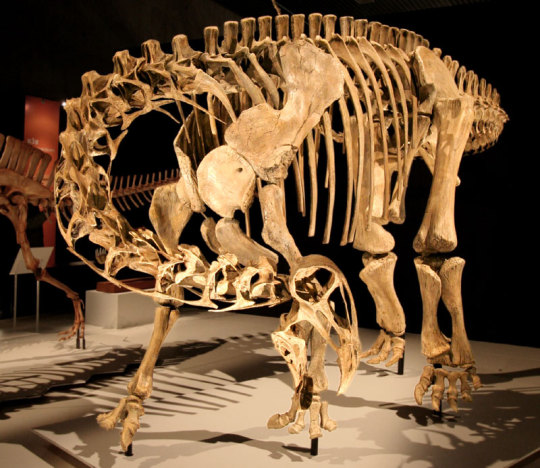

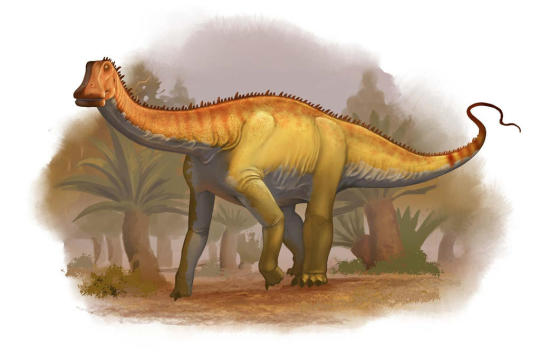
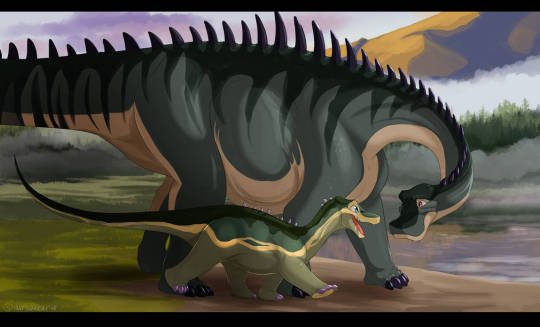

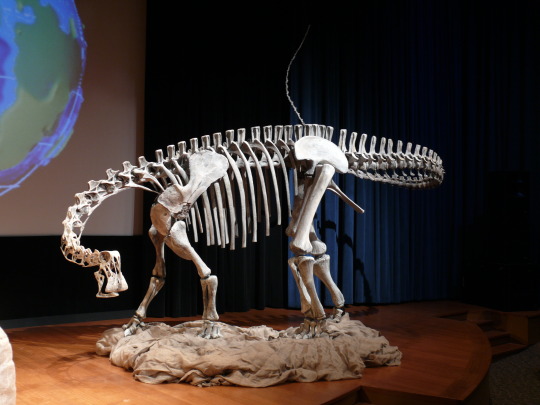
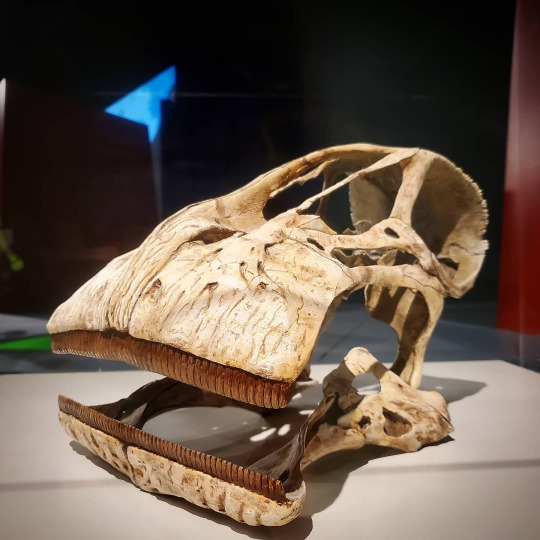
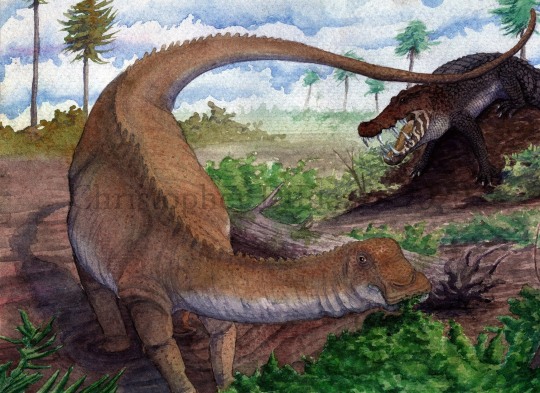

Nigersaurus is a genus of rebbachisaurid sauropod dinosaur that lived throughout what is now africa during the middle Cretaceous period some 115 to 105 million years ago. Remains thought to belong to Nigersaurus were first discovered during a 1965–1972 expedition to the Republic of Niger led by French paleontologist Philippe Taquet, and first mentioned in a paper published in 1976. Although a common genus, the dinosaur had been poorly known until more material of other individuals was discovered during expeditions led by American palaeontologist Paul Sereno in 1997 and 2000. As such Nigersaurus was named and described in more formerly named and described in detail in 1999 by Sereno and his colleagues, The genus name Nigersaurus means Niger reptile in reference to the country where it was discovered, and the specific name taqueti honours Taquet, who was the first to organize large-scale palaeontological expeditions to Niger. The limited understanding of the genus was the result of poor preservation of its remains, which arises from the delicate and highly pneumatic construction of the animals skeleton. Reaching around 30ft (9m) in length and 4,000 to 9,000lbs (1,800 to 4,100kgs) in weight, Nigersaurus was surprisingly small for a sauropod being comparable to a modern elephant. It was a quadrupedal animal with a small head, short neck, thick hind legs, and a prominent tail. Its skull was very specialized for feeding, with large fenestrae and thin bones. It had a wide muzzle filled with more than 500 teeth, which were replaced at a rapid rate: around every 14 days. The jaws may have borne a keratinous sheath giving the animal a beak like structure. In life Nigersaurus was probably a browser, traveling the plains, wetlands, and riverine forest in herds as they feed upon ferns, horsetails, and angiosperms.
Art used can be found at the following links

89 notes
·
View notes
Text
A silly guy

Nigersaurus
A sauropod in the rebbachisauridae family, first discovered by Phillipe Taquet during an expedition from 1965-1972, named in 1999 by Paul Sereno
Now he is named Nigersaurus because he was found in Gadoufaoua, Niger
This needs to be said
Because some people don't like him because they think he's named after a slur
He is not
Nigersaurus is a silly little guy and will be treated as one
Just had to clear that up
Thank you for your time
188 notes
·
View notes
Text

How did the piscivorous Spinosaurus hunt its prey? In response to the heated, ongoing controversy surrounding its supposedly semi aquatic lifestyle, I present three different, hypothetical foraging methods for this highly-unusual theropod.
Top: The “heron-style” hunting method backed up quite recently and by the studies of Paul Sereno. The largely-terrestrial animal waits at the water’s edge for fish to come by and catches them with its jaws.
Middle: If Spinosaurus was definitely a dinosaurian analogue to swans, the “swan-style” method would have seen the animal lowering its head into the water to strike at passing fish.
Bottom: The “cormorant-style” method, backed by Nizar Ibrahim and colleagues, uses the dense bones, short legs, paddle-shaped tail and other adaptations for a semi aquatic lifestyle as evidence for the animal diving and pursuing its prey underwater.
In conclusion, I personally think that it is plausible for Spinosaurus to hunt for its prey in either one or all of these three different methods.
415 notes
·
View notes
Note
Awesome new video on conservation and the Jurassic Park/World movies!
Completely unrelated, but I'm actually a current UChicago PhD student studying paleontology (+ macroevolution and a litany of other stuff), and I'm wondering which evolution/paleo-centric classes you took.
I managed to squeeze into Dinosaur Science during my last semester of 4th year. I dunno if Paul Sereno would remember me, but if you see him, tell him I say hi!
11 notes
·
View notes
Text

Raptorex Kriegsteini
Taxonomic Group: Raptorex kriegsteini is a genus within the family Tyrannosauridae, part of the suborder Theropoda. Although it shares similarities with larger tyrannosaurs like Tyrannosaurus rex, Raptorex was much smaller in size and represents an earlier stage in the evolution of this group.
Size and Weight: Raptorex was a relatively small dinosaur compared to its more famous relatives, measuring about 3 meters (10 feet) in length and weighing approximately 60 kilograms (130 pounds).
Time Period: Raptorex lived during the Late Cretaceous period, around 125 million years ago.
Location: Fossils of Raptorex have been discovered in northeastern China, particularly in the Yixian Formation, a region known for its well-preserved fossils.
Diet: As a carnivore, Raptorex likely fed on small vertebrates, including other dinosaurs. Its sharp teeth and powerful jaws, though smaller than those of later tyrannosaurs, made it a capable predator.
Distinctive Features: Raptorex is characterized by its proportionally large skull, strong forelimbs, and long, muscular legs. Unlike larger tyrannosaurs, its body was more lightly built, allowing for greater agility and speed.
Head Structure: The skull of Raptorex was large in relation to its body size, with numerous sharp teeth well-suited for gripping and tearing flesh. Despite its smaller size, its head structure shares many similarities with later, larger tyrannosaurs.
Movement and Behavior: Raptorex was a bipedal dinosaur, moving on its hind legs. Its long limbs and lighter build suggest it was likely more agile and faster than its larger relatives, relying on speed to hunt smaller prey.
Initial Discovery: The genus Raptorex was described in 2009 by paleontologist Paul Sereno and his colleagues. The name “Raptorex” reflects its status as a smaller, more primitive relative of Tyrannosaurus rex.
Skin and Fossil Finds: Fossil remains of Raptorex include a nearly complete skeleton, providing valuable insights into the anatomy and evolutionary history of early tyrannosaurs.
Social Behavior: There is limited evidence regarding the social behavior of Raptorex. Like other small theropods, it may have been a solitary hunter or possibly lived in small groups.
Adaptations: The smaller size and more agile build of Raptorex suggest adaptations for a different hunting strategy compared to its larger relatives. It may have been more of an opportunistic predator, using its speed and agility to capture swift or elusive prey.
7 notes
·
View notes
Text
Paul Dubois
Narciso 1867
Marmo
Musée d'Orsay 🇫🇷 Parigi
Ph. Michel Waller
Il giovane Narciso, la testa adornata
con le foglie di canna, sta guardando pensierosamente
al suo bel riflesso nell'acqua
del fiume in cui sta per nuotare.
Paul Dubois presenta un dolce e sereno
immagine di questo personaggio della mitologia greca
che comunque è destinato a subire un tragico
il destino. Narciso orgoglioso, che è infatuato
il proprio riflesso, non può amare nessun altro
persona e quindi sarà uccisa dagli dei.
Una prima versione in marmo di questo lavoro è stata
commissionata dallo Stato francese nel 1863 come parte dell'arredamento del cortile Cour carrée del Palazzo del Louvre. 🇫🇷
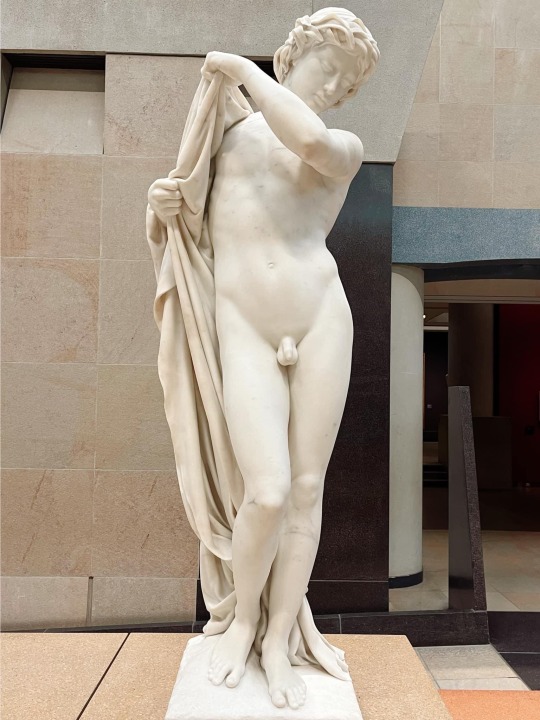

16 notes
·
View notes
Photo

Le Capitaine Dwight D. Eisenhower ( à droite) avec trois amis (William Stuhler, le Major Sereno Elmer Brett et Paul V. Robinson) en 1919, quatre ans après avoir obtenu son diplôme de West Point
©Dwight D. Eisenhower Presidential Library and Museum
#Avant-guerre#Pre-war#Les femmes et les hommes de la guerre#Women and men of war#Personnages militaires#Figures militaires#Military figure#Personnages historiques#Historical figures#Dwight D. Eisenhower#Sereno Elmer Brett#1919
28 notes
·
View notes
Text

É com grande prazer que damos as boas vindas à WILHELM LUDVIG MCCOY, de 28 ANOS. As fofocas dizem que ele se parece muito com PAUL MESCAL, mas ele é apenas o PRÍNCIPE vindo de NOVA IRLANDA. Seja muito bem vindo, WILLYS.
Príncipe Wilhelm, conhecido carinhosamente como Willys, é o herdeiro da realeza da Nova Irlanda, um reino situado em terras repletas de encantos e tradições. Nascido em uma família de sete irmãos, Wilhelm cresceu cercado de amor. Sua vida foi permeada por uma série de experiências marcantes, desde suas aventuras exploratórias ao redor do mundo até seus encontros com diversas culturas e línguas.
Apesar de ser destinado a uma vida de luxo e privilégios, Wilhelm mantém princípios sólidos que o definem. Ele valoriza a liberdade, a amizade e a autenticidade, enxergando além das convenções da realeza. Sua personalidade cativante e charmosa é apenas um aspecto divertido de sua natureza, e ele a utiliza como uma forma de conectar-se com as pessoas ao seu redor. Embora aprecie a vida de luxo que lhe é proporcionada, Wilhelm é consciente das responsabilidades que acompanham sua posição e busca equilibrar a tradição com seu desejo por aventuras e descobertas. Mesmo com o seu casamento marcado para uma herdeira de outro país.
O seu convite, além de ser uma decisão estratégica da família de Wilhelm, é a antiga amizade com o príncipe Alarik. Sua inclusão visa estreitar os laços com a família de Illéa com base nessa amizade, buscando fortalecer alianças políticas e econômicas entre os reinos. Além disso, a participação de Wilhelm é vista como uma oportunidade para mostrar a Nova Irlanda ao mundo e promover sua cultura rica e tradições encantadoras. A família McCoy acredita que, por meio da participação na Seleção, eles podem abrir portas para futuras parcerias e desenvolvimentos favoráveis para ambas as nações.
Wilhelm, por outro lado, encara a participação na Seleção como uma oportunidade emocionante. Ele é a favor dessa experiência, pois vê nela a chance de conhecer e interagir com jovens de diversos lugares, compartilhando suas histórias e perspectivas únicas. Embora tenha apreço por sua vida de luxo e privilégios, Wilhelm também sente uma inquietação dentro de si, uma curiosidade insaciável que o impulsiona a explorar além das fronteiras de seu reino. Participar da Seleção é uma maneira de satisfazer essa sede por novas experiências e, ao mesmo tempo, representar a Nova Irlanda com orgulho e respeito.
Nova Irlanda, um reino repleto de paisagens deslumbrantes e rica herança cultural, é conhecida por sua dedicação à preservação da natureza e à harmonia com o ambiente. As colinas verdejantes e os lagos serenos são testemunhas da beleza que permeia o país. Sua população calorosa e acolhedora é conhecida por celebrar festivais tradicionais e honrar as tradições ancestrais. O país e seu povo orgulham-se de suas lendas e mitos antigos, que são transmitidos de geração em geração, mantendo vivo o espírito único da nação.
1 note
·
View note
Note
whats your favourite dinosaur and why??
The one that looks like this:
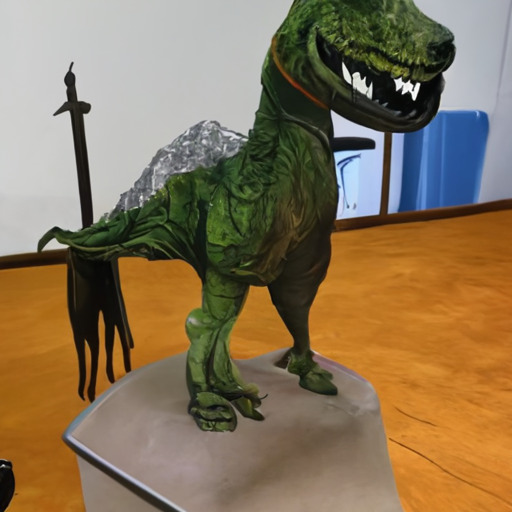
Basically because he's a silly guy. He's a hadrosaur and the first dinosaur I got excited about when I learned about them as a kid. Also because he was the first dinosaur I ever got to see in person, and the first one that I ever actually saw off-screen -- the late Paul Sereno went on a lecture tour when I was in grade school and showed us a video of one of his paleontologists discovering a field of fossils in Niger, including this guy.
The video opened with a female paleontologist discovering the skull of this guy's head, in which you could see some of the individual bones. I remember I was at home with a babysitter and I ran upstairs to my mom to tell her about it, because I had never seen such a complete skull fossil before. (That is also when I came to appreciate the centrality of the skull to a human being's personality. The only time I cried in childhood was when we had to put our dog down, but I didn't start crying until I saw the animal's skull).
Anyway, like, officially official name for this guy is Iguanodon bernissartensis, named for the Bernissart cave in Belgium where these specimens were found.
#i took this picture when i was really little so i didn't realize the eggs and skulls were fake#or maybe i realized but didn't give a shit#though i do have a fondness for skulls#scribonia-art#computer generated image#guidance scale 4
23 notes
·
View notes
Text
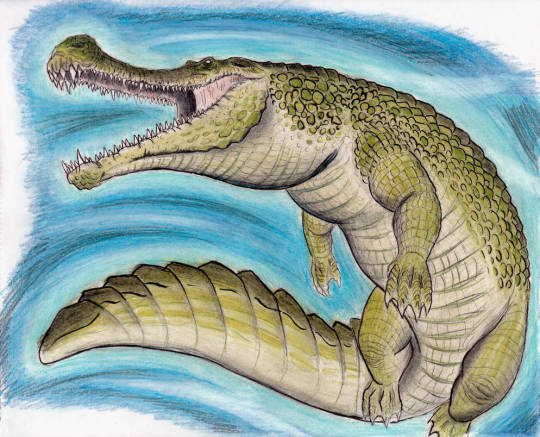
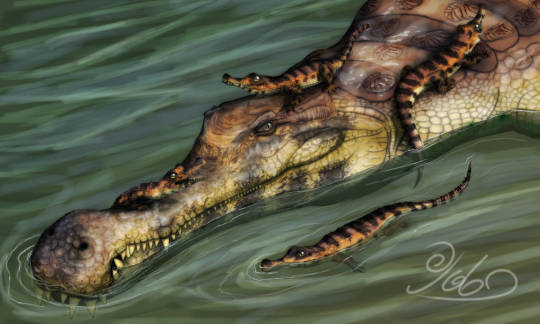
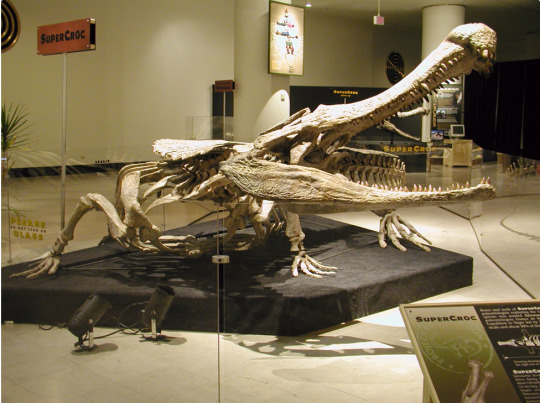


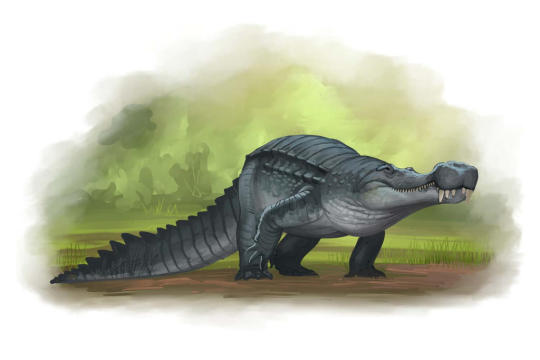

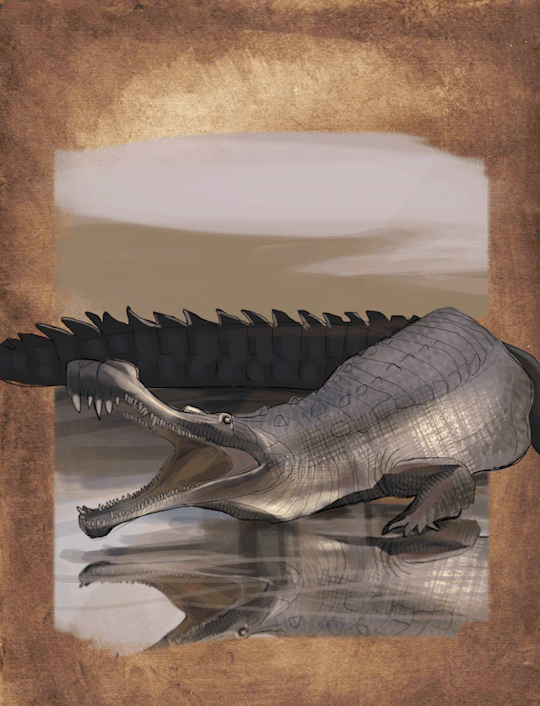
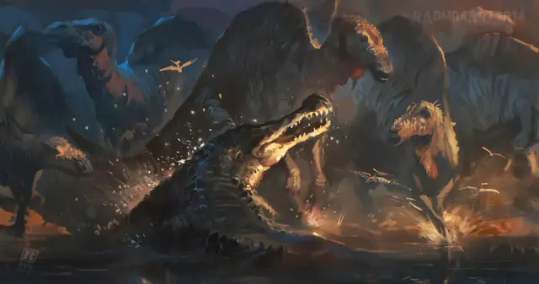

Sarcosuchus is an extinct genus of crocodyliform and distant relative of living crocodilians that lived throughout what is now Africa and South America from the late Hauterivian to the late Cenomanian of the Early Cretaceous Period some 133 to 93 mya. From 1946 to 1959 French paleontologist Albert-Félix de Lapparent lead multiple expeditions into the sahara desert, during such time several crocodyliform fossils consisting of fragments of the skull, teeth, scutes and vertebrae were unearthed in the Continental Intercalaire Formation, Foggara Ben Draou region, Ain el Guettar Formation, and the Elrhaz Formation. These were attributed to a large long snouted yet undiagnostic crocodyliform. Then in 1964 a team of researchers from the French Alternative Energies and Atomic Energy Commission discovered an almost complete skull in the region of Gadoufaoua in Niger. This specimen along was then described by Broin & Taquet in 1966 who named the animal sarcosuchus imperator meaning flesh crocodile supreme ruler. In 1977 a reevalution of material consisting of lower jaw, dorsal scute and two teeth initially found in brazil by American naturalist Charles Hartt in 1897, found them to be Sarcosuchus. These remains where initially classified as a species of Crocodylus then as Goniopholis, and are now considered the type specimen of S. hartti. The next major findings occurred during the expeditions led by the American paleontologist Paul Sereno in 1995, 1997, and 2000. Who discorved 6 fairly complete sarcosuchus individuals. Reaching around 26 to 33ft (8 to 10m) in length and 7,600 to 9,500lbs (3,450 to 4,300 kgs) in weight, sarcosuchus was a benemoth beast. It sported a giant head with elongated jaws, slightly telescoping eyes, and an expansion at the end of its snout known as a bulla. The body was covered in armor and the tail was long and strong yet flexible. In life sarcosuchus would have inhabited inland swamps, lakes, rivers, and wetlands, feeding upon a plethora of fish, amphibians, invertebrates, turtles, lizards, pterosaurs, other crocodyliforms, and even the occasional dinosaur.
Art used can be found at the following links:
15 notes
·
View notes
Text
Hello there!
Welcome to Paleobr33zy where I’ll be blogging fossils. BIG ONES, lil ones, Plants and invertebrates, the whole nine yards.
Our first look will be the newer argument about Spinosaurus: how did it eat? (Based on March 2024 article by the Biological Scientist Division of UChicago)
In 2020, Spinosaurus was proven to be a bipedal semiaquatic theropod with a wide paddle-like tail capable of swimming and diving for prey with its dense bones however this was later disproved by Paul Sereno (the same person whose team initially founded the semiaquatic theory), who created digital skeleton and flesh models of Spinosaurus and older cousin Suchomimus would’ve been unstable swimmers and too bouyant to dive/ fully submerge. As of now this means that Spinosaurus was likely a terrestrial, crane like fisher who snatched food out of the water.

1 note
·
View note
Text
Lo spinosauro non nuotava dopo la cena, afferma uno studio
Lo spinosauro: una questione spinosa tra gli esperti di dinosauri Lo Spinosaurus, uno dei più grandi dinosauri carnivori, mangiava pesce, ma resta un mistero se nuotasse o meno. Alcuni esperti credono che nuotasse sott’acqua come una rarità tra i dinosauri, altri dubitano. Un nuovo studio ribatte alla teoria del nuoto La ricerca pubblicata su PLOS One sostiene che lo Spinosaurus non sapeva nuotare, contraddicendo uno studio precedente che suggeriva il contrario. L’analisi della densità ossea era considerata “statisticamente errata” da Nathan Myhrvold e Paul Sereno. Le argomentazioni a favore della non-natatoria dello Spinosaurus Secondo Myhrvold e Sereno, la struttura del
0 notes
Text
KLEE E UN ANGELO
Seguo Lia Choen sul Magazine iNEWS
“Ci sono due monti su cui tutto è limpido e sereno, il monte degli animali e il monte degli dèi. In mezzo c’è la vita crepuscolare degli uomini” Paul Klee (1903). È forse in questo territorio immaginato dall’artista che vive una delle sue opere più famose “Angelus Novus”, che verrà riprodotta anche nell’ampia monografia Eine Geschichte vom Maler Klee, di Wilhelm Hausenstein. L’acquerello viene…

View On WordPress
0 notes
Text
Todo está a la venta en los Warriors menos Curry. La franquicia trata de evitar el derrumbe de un equipo histórico, aunque aquello ya no volverá
NACHO DUQUE
Los Warriors se acaban. Al menos tal y como los conocemos. Vencieron a los Bulls (131-140), pero el sentimiento de que uno de los mejores equipos de todos los tiempos se extingue no se elimina ganando de vez en cuando partidos de temporada regular. Antes de llegar a Chicago, llevaban seis derrotas en ocho encuentros y las sensaciones eran muy malas. Algo ha de cambiar si se quieren aprovechar los últimos años de Stephen Curry, que cumplirá 36 el próximo marzo.
Resultados de la jornada
Sixers 112-93 Kings
Hawks 108-126 Pacers
Pistons 110-112 Rockets
Heat 99-96 Magic
Bulls 131-140 Warriors
Grizzlies 119-128 Clippers
Timberwolves 116-93 Blazers
Spurs 135-99 Hornets
Jazz 145-113 Raptors
Nuggets 125-113 Pelicans
El base lo dijo tras la dolorosa derrota ante los Pelicans por 105-141: "Es bastante evidente que si las cosas siguen igual...". El periodista Shams Charania asegura que toda la plantilla a excepción de Curry está en el mercado. Pueden ser unos de los grandes animadores del mismo. Cuesta imaginar unos Warriors sin Klay Thompson o Draymond Green que aún no ha regresado de su 'rehabilitación' indefinida. Sería el desmembramiento del equipo campeón en 2015, 2017, 2018 y 2022, los llegaron a cinco finales seguidas y seis de ocho.
Los cambios son obligados. Otra cosa es que lo que pueden ofrecer sea sugerente. Thompson no es el mismo desde las dos graves lesiones que sufrió, Green sereno es determinante, ¿pero conseguirá estarlo mucho tiempo?, Andrew Wiggins fue decisivo en una final aunque se ha instalado en la irregularidad, el ahora lesionado y veteranísimo Chris Paul, Gary Payton II, Jonathan Kuminga, Kevon Looney, los jóvenes que empiezan a despuntar... Habría que ver lo que pueden conseguir, aunque muy bueno debería ser o muy bien tendría que salir para reflotar el juego y el ánimo del equipo.
Curry y Thompson recuerdan los viejos tiempos para ganar en Chicago
En Chicago, los Warriors se rehicieron tras un mal inicio de Curry y Thompson, que fallaron 10 de sus 11 primeros tiros. El primero metió 27 puntos, 15 de ellos en el último cuarto, con 6/15 en triples. El segundo se fue a los 30 puntos, con 7/15 desde el perímetro. Los 'Splash Brothers' conservan su magia, aunque se vea cada vez menos de forma conjunta. Kuminga añadió 24 puntos con cuatro triples sin fallo y Wiggins tuvo una completa actuación con 15 puntos, cinco rebotes y ocho asistencias.
Por los Bulls, DeMar DeRozan llegó a los 39 mientras Coby White y Zach LaVine metieron 25 por cabeza. La franquicia de Chicago homenajeó a la plantilla que ganó el anillo de 1995, aunque faltaron��Michael Jordan y Scottie Pippen, lo que deslució el acto. Los Warriors, en uno de los últimos coletazos de lo que fueron, terminaron de chafarles el homenaje.
Los Clippers continúan con su mutación
Cuando James Harden llegó, los Clippers sufrieron cinco derrotas seguidas. Pidió un margen de 10 partidos para ser juzgados. Sabía de lo que hablaba. Desde que arrancara diciembre, no hay mejor equipo en la NBA. Su balance es de 17-3 tras ganar ocho de los últimos nueve encuentros. En el último ante los Grizzlies (119-128). Paul George fue el mejor de los angelinos con 37 puntos y 7/10 en triples, Kawhi Leonard hizo 22, Russell Westbrook metió 12 y Harden 11 con nueve asistencias.
Enfrente, unos Grizzlies en depresión y con la enfermería a rebosar. Sin Ja Morant, Marcus Smart, Steven Adams, Brandon Clake, Derrick Rose y el español Santi Aldama. Para colmo de males se lesionó también Desmond Bane, su referente esta temporada entre tanta baja. Anotó 15 puntos antes de retirarse en el tercer cuarto por una torcedura en el tobillo izquierdo. En Memphis están gafados.
Los Blazers acumulan dos palizas en 24 horas: -85
Los Blazers venían de sufrir la quinta mayor derrota en la historia de la NBA con un -62 ante los Thunder.
En el segundo partido en noches consecutivas y en casa de los Timberwolves, líderes del Oeste, nada bueno para ellos podía esperarse. Perdieron por 116-93. Una nueva paliza, que elevó a -85 la cuenta de los dos últimos encuentros.
Los de Minnesota no encontraron demasiada oposición. En un día sin brillo de Anthony Edwards (nueve puntos), destacaron Rudy Gobert, amo y señor de los tableros con 24 puntos y 17 rebotes, y Karl-Anthony Towns, que hizo 23+8.
Los Pacers se crecen sin Haliburton
La distensión en el tendón de la corva izquierda de Tyrese Haliburton, motor de los Pacers y mejor asistente de la NBA, hacía pensar que el equipo podía bajar su rendimiento. Por el momento no es así. Derrotaron a los Hawks (108-126) en la que fue su novena victoria en 10 encuentros, lo que supone el mejor dato de la NBA desde Navidad.
Sin su referente, el cerebro fue TJ McConnell, uno de sus bases que suele estar fuera del foco pero que siempre ofrece un gran rendimiento. Saliendo del banquillo repartió 14 asistencias en 25 minutos. Sus compañeros Buddy Hield y Obi Toppin lideraron la repartida anotación de Indiana (ocho jugadores por encima de los 10 puntos) con 18 cada uno.
Para recibir en tu celular esta y otras informaciones, únete a nuestras redes sociales, síguenos en Instagram, Twitter y Facebook como @DiarioElPepazo
El Pepazo/Marca
0 notes